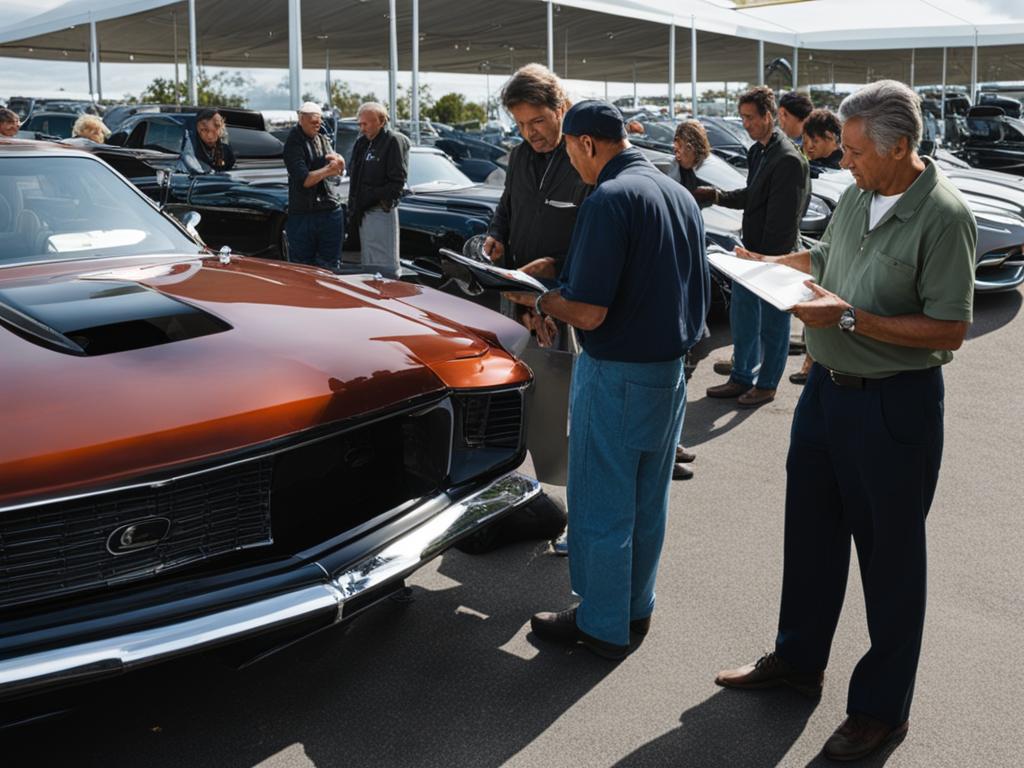Trading In Two Cars for One – Your Guide
If you have two cars that you no longer need and are considering upgrading to a single vehicle, you may be wondering if it’s possible to trade in both cars for one. While the final decision ultimately rests with the dealer, it is possible to negotiate a two-car trade-in for one. The value of the new car compared to the value of your trade-ins will play a significant role in the deal. To ensure a smooth transaction, it’s important to do your due diligence by negotiating the retail values of the trade-in cars separately, having all necessary documents ready, and being cautious when trading cars with remaining loan balances.
Key Takeaways:
- You can negotiate a two-car trade-in for one, but it ultimately depends on the dealer’s decision.
- Be prepared by negotiating the values of the trade-in cars separately and having all documents in order.
- Exercise caution when trading cars with remaining loan balances to avoid potential complications.
- Research the current trade-in values of your cars and consider enhancing their value to secure a better deal.
- Shop around and gather multiple trade-in quotes to compare offers and evaluate the best deal.
Tips for Negotiating a Two-Car Trade-in
When it comes to negotiating a two-car trade-in, there are several tips that can help you increase your chances of securing a favorable deal. By following these strategies, you can navigate the trade-in process with confidence and maximize the trade-in value for both of your cars.
Negotiate the Retail Values Separately
An essential tip for negotiating a two-car trade-in is to first negotiate the retail values of the trade-in cars separately before discussing the prices of the new car. This approach allows you to gain a better understanding of the individual values of each car and empowers you during the negotiation process. By knowing the worth of each car, you can make more informed decisions and ensure that your trade-in is valued fairly.
Gather All Necessary Documents
Prior to initiating the trade-in process, it is crucial to have all the necessary documents readily available. This includes documents such as the title, registration, and maintenance records of each car. By having these documents on hand, you can demonstrate that your cars are well-maintained and provide the necessary proof to support the value of your trade-in.
Exercise Caution with Remaining Loan Balances
If one or both of your cars have remaining loan balances, it’s important to exercise caution during the trade-in process. Trading in a car with an outstanding loan can result in the remaining balance being rolled into the subsequent car loan, potentially increasing your monthly payments. Before finalizing the trade-in, carefully consider whether it is more financially beneficial to postpone the trade-in or explore alternative options.
Engage in Open Communication
Open communication with the dealer is crucial throughout the negotiation process. Be transparent about the condition of your cars, providing accurate and detailed information. This can help establish trust and enhance the likelihood of reaching a mutually beneficial agreement. Regularly communicate your expectations, concerns, and questions to ensure a smooth and satisfactory trade-in experience.
Keep the Trade-In Offer in Writing
To protect yourself and maintain clarity throughout the trade-in process, it is recommended to request the trade-in offer in writing. Having a written record of the agreement helps to avoid any confusion or changes in the terms of the trade-in deal. By keeping everything documented, you can safeguard your interests and ensure that both parties adhere to the negotiated terms.
By following these tips and strategies, you can negotiate a two-car trade-in with confidence and increase your chances of securing a favorable deal. Remember to prepare in advance, engage in open communication, and be assertive during negotiations. With the right approach, you can successfully navigate the trade-in process and upgrade to your desired vehicle.
Enhancing the Trade-in Value of Your Cars
To maximize the trade-in value of your cars, there are certain steps you can take. By boosting the trade-in value of your cars, you can increase the overall value of the deal and potentially save money on your new vehicle. Here are some tips to help you increase the trade-in value:
- Research the current trade-in value: Before approaching the dealership, research the current trade-in value of each car using reliable sources like Kelley Blue Book and Edmunds. This will give you an idea of the market value and help you set realistic expectations.
- Address repairs: Be honest about the condition of your cars and consider making minor mechanical repairs. Fixing issues like faulty brakes or worn-out tires can significantly increase the trade-in value of your cars.
- Fix cosmetic issues: Cosmetic issues such as dents, scratches, and broken lights can negatively impact the trade-in value. Consider addressing these cosmetic fixes to enhance the overall appeal and value of your cars.
- Maintain regular maintenance: Regular maintenance helps in keeping your cars in good condition. This includes routine oil changes, tire rotations, and fluid checks. Keeping up with maintenance and retaining records can show potential buyers that your cars have been well-cared for.
- Detail your cars: Cleanliness plays an essential role in making a good impression. Thoroughly clean the interior and exterior of your cars, paying attention to details like vacuuming the carpets, polishing the exterior, and ensuring the vehicle smells fresh.
“By taking these steps to enhance the trade-in value of your cars, you can maximize the overall value of the deal and increase your chances of a higher trade-in offer.”
Remember, a clean and attractive vehicle is more likely to fetch a higher trade-in value. By investing some time and effort into improving the condition and appearance of your cars, you can increase your chances of maximizing the trade-in value and securing a better deal.
| Steps to Enhance Trade-in Value | Benefits |
|---|---|
| Research current trade-in value | Set realistic expectations and avoid undervaluation |
| Address repairs and maintenance | Increase the overall condition and appeal of your cars |
| Fix cosmetic issues | Present a well-maintained and attractive vehicle |
| Maintain regular maintenance | Showcase proper care and increase buyer confidence |
| Detail your cars | Create a positive first impression and make your cars stand out |
By following these steps and presenting your cars in the best possible condition, you can enhance the trade-in value and increase your chances of securing a better deal.
Shopping Around for Trade-in Value
Before finalizing a trade-in deal, it’s crucial to shop around and compare multiple trade-in offers to ensure you’re getting the best value for your cars. By obtaining quotes from different sources, such as Carvana, CarMax, and other major used car dealers in your area, you can gain a better understanding of the baseline trade-in value for your vehicles.
Comparing trade-in offers enables you to evaluate the range of values you’re likely to receive and make an informed decision. While one dealer may offer a higher trade-in value, another may provide additional incentives or benefits that make their offer more attractive. It’s important to consider all factors, including the overall deal, when evaluating trade-in offers.
Comparing Trade-in Offers: An Example
Let’s say you’re trading in two cars for one and have received the following trade-in offers:
| Dealer | Trade-in Value for Car 1 | Trade-in Value for Car 2 | Overall Trade-in Value |
|---|---|---|---|
| Carvana | $10,000 | $8,000 | $18,000 |
| CarMax | $9,500 | $9,500 | $19,000 |
| Local Dealer | $10,500 | $7,500 | $18,000 |
Based on these offers, CarMax is offering the highest overall trade-in value of $19,000. However, it’s important to consider other factors such as the condition of your cars and any additional benefits offered by each dealer.
Remember, the trade-in value is just one part of the overall deal. You may also want to consider factors such as financing options, warranty coverage, and customer service when evaluating trade-in offers.

By comparing trade-in offers from multiple sources, you can make an informed decision and ensure that you’re getting the most favorable offer for your trade-ins. Take the time to research and evaluate each offer, considering both the trade-in value and the overall deal. Armed with this information, you’ll have a better chance of securing the best trade-in value and making a smooth transition to your new vehicle.
Separate Negotiations for Trade-in and Purchase
When it comes to trading in your cars and purchasing a new vehicle, one effective strategy is to negotiate the trade-in value and purchase price separately. By approaching these two aspects as separate negotiations, you can optimize your chances of securing the best deal. This approach allows you to focus solely on getting the best trade-in value for your cars without the influence of the price of the new vehicle. It provides you with more control over each transaction, increasing the likelihood of obtaining favorable terms.
By negotiating the trade-in value separately, you can ensure that the dealer assesses the worth of your cars independently, maximizing their individual value. This prevents the trade-in value from being overshadowed by the purchase price, allowing you to negotiate each element on its own merits.
Furthermore, when negotiating trade-in value separately, it is recommended to request the offer in writing. This written documentation protects you from any changes or inconsistencies in the deal and serves as a reference point during the negotiation process.
Overall, conducting separate negotiations for trade-in and purchase empowers you to make informed decisions and secure the best possible trade-in value for your cars. It offers greater transparency and control, ensuring a more favorable outcome for your trade-in experience.
| Benefits of Separate Negotiations | Considerations |
|---|---|
|
|
Timing Your Trade-in for Optimal Value
The timing of your trade-in can significantly impact the value you receive for your cars. By strategically choosing the best time to trade in your car, you can maximize your trade-in value. Generally, the first two quarters of the year are considered a good time to trade in a vehicle due to higher buyer demand. However, there are other factors to consider that can further enhance the value of your trade-in.

Factors such as weather conditions and specific vehicle models can influence the offer you receive on your trade-in. For example, if you’re planning to trade in an all-wheel-drive SUV, doing so during the winter or before the start of the spring college semester may yield a higher value due to increased demand for such vehicles.
It’s essential to stay updated on market conditions and carefully assess demand for specific vehicle types in your area. By doing so, you can strategically time your trade-in to align with periods of higher demand, ultimately securing a better deal.
Benefits of Timing Your Trade-in:
- Increased trade-in value: Timing your trade-in during periods of high demand can allow you to negotiate a higher trade-in value for your car.
- Larger selection of vehicles: Trading in your car during optimal timing gives you a wider range of new cars to choose from, increasing your chances of finding the perfect vehicle.
- Competitive advantage: By trading in your car at the right time, you may have an advantage over buyers who are looking to purchase a similar vehicle, increasing the likelihood of getting a better deal.
“Timing your trade-in strategically based on market conditions and demand can help you secure a better deal.”
Take the time to research and identify the optimal timing for trading in your specific type of car. Keep in mind that while specific market trends can provide a general sense of the best time to trade in, individual factors such as your location and the condition of your car can also influence the ideal timing for your trade-in.
| Factors to Consider for Timing Your Trade-in | Impact on Trade-in Value |
|---|---|
| Seasonal Demand | Affects the desirability and trade-in value of certain types of vehicles. |
| Weather Conditions | All-wheel-drive vehicles may command a higher trade-in value during inclement weather. |
| Economic Climate | Can influence buyer demand and the trade-in value of vehicles. |
| New Model Releases | Trade-in value may be affected by the introduction of new models in the market. |
By considering these factors and conducting thorough research, you can strategically time your trade-in to optimize the value of your cars.
Considerations for Trading in a Car with an Outstanding Loan
If you find yourself in a situation where you have an outstanding loan on one or both of your cars but want to trade them in, there are some important considerations to keep in mind. One of the key factors is the presence of negative equity, which refers to the difference between the remaining loan balance and the trade-in value of the car.
Trading in a car with negative equity can have implications for your next car loan. The remaining balance on your current loan may be rolled into the loan for the new car, potentially increasing your monthly payments. It’s essential to carefully evaluate whether it’s more advantageous to postpone the trade-in until the negative equity is reduced or sell the car independently.
By selling the car independently, you can try to minimize the impact of negative equity by using the proceeds from the sale to pay off the loan in full. This approach can help you avoid rolling the negative equity into the new loan and potentially save money in the long run.
It’s important to consider your financial situation, including your budget, before making a decision. If you’re unsure about the best course of action, it’s recommended to consult with a financial advisor or speak with your lender to understand the potential consequences of trading in a car with an outstanding loan.
Case Study: Trading in a Car with Negative Equity
| Current Car | Loan Balance | Trade-in Value | Negative Equity |
|---|---|---|---|
| Car A | $15,000 | $12,000 | $3,000 |
| Car B | $10,000 | $9,000 | $1,000 |
“I had two cars with outstanding loans, and I wanted to trade them in for a new vehicle. However, the trade-in values were less than the remaining loan balances, resulting in negative equity. After considering my options, I decided to sell one of the cars privately to pay off the loan and mitigate the impact of negative equity. This allowed me to negotiate a better deal for the new car without rolling the negative equity into the loan.
Every situation is unique, and the decision to trade in a car with an outstanding loan depends on various factors. It’s crucial to carefully evaluate your financial circumstances and consider the potential consequences before proceeding.
Preparing for a Smooth Trade-in Process
When it comes to trading in your cars, proper preparation can make all the difference in ensuring a smooth and successful transaction. By taking a few steps in advance, you can streamline the trade-in process and increase your chances of getting a favorable deal.
Gather the Necessary Documents
Start by collecting all the required documents for each car you plan to trade in. These documents typically include the title, registration, and maintenance records. Having these documents readily available will help expedite the trade-in process and provide the dealer with necessary information.
Check for Vehicle Recalls and Repairs
Prioritize the safety and reliability of your cars by checking for any open recalls. Addressing these recalls before trading in your vehicles not only ensures the well-being of future owners but can also enhance the trade-in value. Additionally, considering any necessary repairs or maintenance items can further increase the appeal and value of your cars.
Pull a Car History Report
Providing a car history report to the dealer can serve as evidence of proper vehicle maintenance and care, potentially increasing the trade-in value. Consider pulling a comprehensive report that includes information such as accident history, the number of owners, and service records. A clean and well-maintained history can positively impact the trade-in offer.
Thoroughly Clean and Detail Your Cars
First impressions matter, even when it comes to trade-ins. Before taking your cars to the dealership, invest time in thoroughly cleaning and detailing them. A clean and presentable vehicle not only creates a positive impression but can also lead to a higher trade-in value. Pay attention to both the interior and exterior, ensuring that every nook and cranny is clean and well-maintained.
By following these preparatory steps, you can enhance your chances of a successful trade-in process. With all the necessary paperwork and well-maintained vehicles in hand, you’re one step closer to upgrading to your desired vehicle.
| Steps for Preparing for a Smooth Trade-in Process |
|---|
| Gather all necessary documents (title, registration, maintenance records) |
| Check for vehicle recalls and fix any necessary repairs |
| Pull a car history report to provide to the dealer |
| Thoroughly clean and detail your cars |

Exploring Alternatives to Trading in Two Cars for One
While trading in two cars for one is a common approach, it’s worth exploring alternative options. Selling each car independently to private buyers can potentially yield higher returns compared to a trade-in. Although this requires more effort in terms of marketing and negotiations, it can be a viable option if maximizing the value of your cars is a priority. Additionally, you can consider selling one car and keeping the other as a backup or using it for other purposes. Evaluating these alternatives can help you make an informed decision based on your specific circumstances.
Conclusion
Trading in two cars for one is a viable option in the car trade-in process, although the final decision ultimately rests with the dealer. By following the tips and considerations outlined in this guide, you can increase your chances of obtaining a favorable trade-in deal.
Researching the trade-in values of your cars separately, gathering all necessary documents, and negotiating the trade-in value and purchase price separately are crucial steps to ensure a smooth transaction. Timing your trade-in strategically based on market conditions and demand can also have a significant impact on the value you receive.
However, it’s important to note that there are alternative options to consider, such as selling each car independently to private buyers. This may result in potentially higher returns compared to a trade-in, but it requires more effort in terms of marketing and negotiations.
Ultimately, approaching the trade-in process strategically, being well-informed, and exploring all available options will help you streamline the transaction and upgrade to your desired vehicle smoothly. Good luck with your trade-in journey!
FAQ
Can I trade in two cars for one?
Trading in two cars for one is possible, although the final decision rests with the dealer. The value of the new car compared to the trade-in cars will play a significant role in the deal.
How do I negotiate a two-car trade-in?
When negotiating a two-car trade-in, it’s important to negotiate the retail values of the trade-in cars separately before discussing the prices of the new car. This allows you to have a better understanding of the individual values of each car.
How can I enhance the trade-in value of my cars?
To maximize the trade-in value of your cars, research their current trade-in value, consider fixing minor mechanical issues and cosmetic fixes, keep up with regular maintenance, and ensure the cars are clean and well-maintained.
How do I shop around for trade-in value?
Before finalizing a trade-in deal, it’s crucial to gather multiple trade-in quotes from different sources such as Carvana, CarMax, and other major used car dealers in your area.
Should I negotiate trade-in value separately from the purchase price?
It’s recommended to negotiate trade-in value separately from the purchase price. By separating the negotiations, you can focus on getting the best trade-in value for your cars without being influenced by the price of the new vehicle.
What is the best time to trade in a car?
The first two quarters of the year tend to be a good time to trade in a vehicle due to higher buyer demand.
What should I consider when trading in a car with an outstanding loan?
If you have an outstanding loan on one or both of your cars, it’s important to consider the amount of negative equity you may have and evaluate whether it’s more beneficial to postpone the trade-in or sell the car independently.
How can I prepare for a smooth trade-in process?
To ensure a smooth trade-in process, gather all necessary documents, check for vehicle recalls, fix any issues, pull a car history report, and thoroughly clean and detail your cars.
Are there alternatives to trading in two cars for one?
Yes, selling each car independently to private buyers or keeping one car as a backup or for other purposes are alternatives to trading in two cars for one.




